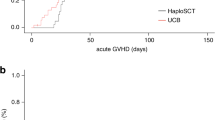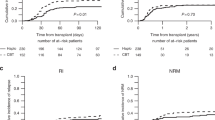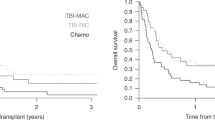Abstract
Relapsed or refractory neuroblastoma is uniformly fatal. We hypothesized that allogeneic response could provide a platform for immunotherapy in neuroblastoma. We therefore undertook a pilot trial of unrelated cord blood transplantation after reduced intensity conditioning regimen (RIC) in children with relapsed neuroblastoma to assess engraftment and tolerability in this heavily pretreated population. The RIC included CY (50 mg/kg, day −6), fludarabine (40 mg/m2, days −6 to −2), total body irradiation (200 cGy, day −1), and rabbit anti-thymocyte globulin (2.5 mg/kg, days −3 to −1). Six patients were enrolled: four were in partial responsive relapse, one with a mixed response and one in refractory relapse. All patients tolerated the regimen well and had donor engraftment with full neutrophil and plt recovery (median time 12 and 35 days, respectively). One patient never experienced neutropenia and another did not need plt transfusions. All patients progressed after transplant (median time 55 days, 26–180 days). Natural killer (NK) cell counts were normal within 2 months, whereas T-cell recovery was slower. In conclusion, unrelated cord blood engrafts after RIC in children with refractory neuroblastoma. Future research should be aimed at transplanting patients with minimal residual disease, using less intensive immunosuppression and adding NK-cell based post transplant immunotherapy.
This is a preview of subscription content, access via your institution
Access options
Subscribe to this journal
Receive 12 print issues and online access
$259.00 per year
only $21.58 per issue
Buy this article
- Purchase on Springer Link
- Instant access to full article PDF
Prices may be subject to local taxes which are calculated during checkout
Similar content being viewed by others
References
Demirer T, Barkholt L, Blaise D, Pedrazzoli P, Aglietta M, Carella AM et al. Transplantation of allogeneic hematopoietic stem cells: an emerging treatment modality for solid tumors. Nat Clin Pract Oncol 2008; 5: 256–267.
Matthay KK, Seeger RC, Reynolds CP, Stram DO, O’Leary MC, Harris RE et al. Allogeneic versus autologous purged bone marrow transplantation for neuroblastoma: a report from the Childrens Cancer Group. J Clin Oncol 1994; 12: 2382–2389.
Ladenstein R, Lasset C, Hartmann O, Klingebiel T, Bouffet E, Gadner H et al. Comparison of auto versus allografting as consolidation of primary treatments in advanced neuroblastoma over one year of age at diagnosis: report from the European Group for Bone Marrow Transplantation. Bone Marrow Transplant 1994; 14: 37–46.
Inoue M, Nakano T, Yoneda A, Nishikawa M, Nakayama M, Yumura-Yagi K et al. Graft-versus-tumor effect in a patient with advanced neuroblastoma who received HLA haplo-identical bone marrow transplantation. Bone Marrow Transplant 2003; 32: 103–106.
Marabelle A, Paillard C, Tchirkov A, Halle P, Chassagne J, Demeocq F et al. Graft-versus-tumour effect in refractory metastatic neuroblastoma. Bone Marrow Transplant 2007; 39: 809–810.
Gratwohl A, Baldomero H, Frauendorfer K, Rocha V, Apperley J, Niederwieser D . The EBMT activity survey 2006 on hematopoietic stem cell transplantation: focus on the use of cord blood products. Bone Marrow Transplant 2008; 41: 687–705.
Hirayama M, Azuma E, Araki M, Komada Y, Nakagawa A . Evidence of graft-versus-tumor effect in refractory metastatic neuroblastoma. Transplantation 2006; 82: 142–144.
Yoshida H, Kusuki S, Hashii Y, Ohta H, Morio T, Ozono K . Ex vivo-expanded donor CD4(+) lymphocyte infusion against relapsing neuroblastoma: a transient graft-versus-tumor effect. Pediatr Blood Cancer 2009; 52: 895–897.
Perez-Martinez A, Leung W, Munoz E, Iyengar R, Ramirez M, Vicario JL et al. KIR-HLA receptor-ligand mismatch associated with a graft-versus-tumor effect in haploidentical stem cell transplantation for pediatric metastatic solid tumors. Pediatr Blood Cancer 2009; 53: 120–124.
Kolb HJ . Graft-versus-leukemia effects of transplantation and donor lymphocytes. Blood 2008; 112: 4371–4383.
Toporski J, Garkavij M, Tennvall J, Ora I, Gleisner KS, Dykes JH et al. High-dose iodine-131-metaiodobenzylguanidine with haploidentical stem cell transplantation and posttransplant immunotherapy in children with relapsed/refractory neuroblastoma. Biol Blood Marrow Transplant 2009; 15: 1077–1085.
Ruggeri L, Capanni M, Urbani E, Perruccio K, Shlomchik WD, Tosti A et al. Effectiveness of donor natural killer cell alloreactivity in mismatched hematopoietic transplants. Science 2002; 295: 2097–2100.
Hambach L, Vermeij M, Buser A, Aghai Z, van der KT, Goulmy E . Targeting a single mismatched minor histocompatibility antigen with tumor-restricted expression eradicates human solid tumors. Blood 2008; 112: 1844–1852.
Robinson N, Sanders JE, Benyunes MC, Beach K, Lindgren C, Thompson JA et al. Phase I trial of interleukin-2 after unmodified HLA-matched sibling bone marrow transplantation for children with acute leukemia. Blood 1996; 87: 1249–1254.
Alpdogan O, Muriglan SJ, Eng JM, Willis LM, Greenberg AS, Kappel BJ et al. IL-7 enhances peripheral T cell reconstitution after allogeneic hematopoietic stem cell transplantation. J Clin Invest 2003; 112: 1095–1107.
Alpdogan O, Eng JM, Muriglan SJ, Willis LM, Hubbard VM, Tjoe KH et al. Interleukin-15 enhances immune reconstitution after allogeneic bone marrow transplantation. Blood 2005; 105: 865–873.
Arellano ML, Langston A, Winton E, Flowers CR, Waller EK . Treatment of relapsed acute leukemia after allogeneic transplantation: a single center experience. Biol Blood Marrow Transplant 2007; 13: 116–123.
Ash S, Gigi V, Askenasy N, Fabian I, Stein J, Yaniv I . Graft versus neuroblastoma reaction is efficiently elicited by allogeneic bone marrow transplantation through cytolytic activity in the absence of GVHD. Cancer Immunol Immunother 2009; 58: 2073–2084.
Rocha V, Cornish J, Sievers EL, Filipovich A, Locatelli F, Peters C et al. Comparison of outcomes of unrelated bone marrow and umbilical cord blood transplants in children with acute leukemia. Blood 2001; 97: 2962–2971.
Michel G, Rocha V, Chevret S, Arcese W, Chan KW, Filipovich A et al. Unrelated cord blood transplantation for childhood acute myeloid leukemia: a Eurocord Group analysis. Blood 2003; 102: 4290–4297.
Barker JN, Davies SM, DeFor T, Ramsay NK, Weisdorf DJ, Wagner JE . Survival after transplantation of unrelated donor umbilical cord blood is comparable to that of human leukocyte antigen-matched unrelated donor bone marrow: results of a matched-pair analysis. Blood 2001; 97: 2957–2961.
Eapen M, Rubinstein P, Zhang MJ, Stevens C, Kurtzberg J, Scaradavou A et al. Outcomes of transplantation of unrelated donor umbilical cord blood and bone marrow in children with acute leukaemia: a comparison study. Lancet 2007; 369: 1947–1954.
Dalle JH, Duval M, Moghrabi A, Wagner E, Vachon MF, Barrette S et al. Results of an unrelated transplant search strategy using partially HLA-mismatched cord blood as an immediate alternative to HLA-matched bone marrow. Bone Marrow Transplant 2004; 33: 605–611.
Barker JN, Weisdorf DJ, DeFor TE, Blazar BR, Miller JS, Wagner JE . Rapid and complete donor chimerism in adult recipients of unrelated donor umbilical cord blood transplantation after reduced-intensity conditioning. Blood 2003; 102: 1915–1919.
Adamkiewicz TV, Szabolcs P, Haight A, Baker KS, Staba S, Kedar A et al. Unrelated cord blood transplantation in children with sickle cell disease: review of four-center experience. Pediatr Transplant 2007; 11: 641–644.
Bradley MB, Satwani P, Baldinger L, Morris E, Van de Ven C, Del TG et al. Reduced intensity allogeneic umbilical cord blood transplantation in children and adolescent recipients with malignant and non-malignant diseases. Bone Marrow Transplant 2007; 40: 621–631.
Tolar J, Bonfim C, Grewal S, Orchard P . Engraftment and survival following hematopoietic stem cell transplantation for osteopetrosis using a reduced intensity conditioning regimen. Bone Marrow Transplant 2006; 38: 783–787.
Takami A, Takamatsu H, Yamazaki H, Ishiyama K, Okumura H, Ohata K et al. Reduced-intensity unrelated cord blood transplantation for treatment of metastatic renal cell carcinoma: first evidence of cord-blood-versus-solid-tumor effect. Bone Marrow Transplant 2006; 38: 729–732.
Acquaviva C, Duval M, Mirebeau D, Bertin R, Cave H . Quantitative analysis of chimerism after allogeneic stem cell transplantation by PCR amplification of microsatellite markers and capillary electrophoresis with fluorescence detection: the Paris-Robert Debre experience. Leukemia 2003; 17: 241–246.
Przepiorka D, Weisdorf D, Martin P, Klingemann HG, Beatty P, Hows J et al. 1994 Consensus conference on acute GVHD grading. Bone Marrow Transplant 1995; 15: 825–828.
Filipovich AH, Weisdorf D, Pavletic S, Socie G, Wingard JR, Lee SJ et al. National Institutes of Health consensus development project on criteria for clinical trials in chronic graft-versus-host disease: I. Diagnosis and staging working group report. Biol Blood Marrow Transplant 2005; 11: 945–956.
Bader P, Hancock J, Kreyenberg H, Goulden NJ, Niethammer D, Oakhill A et al. Minimal residual disease (MRD) status prior to allogeneic stem cell transplantation is a powerful predictor for post-transplant outcome in children with ALL. Leukemia 2002; 16: 1668–1672.
Corrias MV, Occhino M, Croce M, De AA, Pistillo MP, Bocca P et al. Lack of HLA-class I antigens in human neuroblastoma cells: analysis of its relationship to TAP and tapasin expression. Tissue Antigens 2001; 57: 110–117.
Dalle JH, Dardari R, Menezes J, Cordeiro P, Champagne MA, Duval M . Binding of thymoglobulin to natural killer cells leads to cell activation and interferon-gamma production. Transplantation 2009; 87: 473–481.
Brunstein CG, Weisdorf DJ, DeFor T, Barker JN, Tolar J, Van Burik JA et al. Marked increased risk of Epstein-Barr virus-related complications with the addition of anti-thymocyte globulin to a non-myeloablative conditioning prior to unrelated umbilical cord blood transplantation. Blood 2006; 108: 2874–2880.
Vandenbosch K, Ovetchkine P, Champagne MA, Haddad E, Alexandrov L, Duval M . Varicella-zoster virus disease is more frequent after cord blood than after bone marrow transplantation. Biol Blood Marrow Transplant 2008; 14: 867–871.
Acknowledgements
We are very grateful to our patients and their families: they made this research possible. This publication was supported by grants from la Fondation du Centre de Cancérologie Charles-Bruneau and Fonds de la Recherche en Santé du Québec. CJ is a fellow of la Fondation du Centre de Cancérologie Charles-Bruneau. MD is a recipient of a clinical research junior scientist award from the Fonds de la Recherche en Santé du Québec.
Author information
Authors and Affiliations
Corresponding author
Ethics declarations
Competing interests
The authors declare no conflict of interest.
Rights and permissions
About this article
Cite this article
Jubert, C., Wall, D., Grimley, M. et al. Engraftment of unrelated cord blood after reduced-intensity conditioning regimen in children with refractory neuroblastoma: a feasibility trial. Bone Marrow Transplant 46, 232–237 (2011). https://doi.org/10.1038/bmt.2010.107
Received:
Revised:
Accepted:
Published:
Issue Date:
DOI: https://doi.org/10.1038/bmt.2010.107
Keywords
This article is cited by
-
Allogeneic hematopoietic cell transplantation for neuroblastoma: the CIBMTR experience
Bone Marrow Transplantation (2013)
-
Reduced-intensity conditioning followed by allogeneic transplantation in pediatric malignancies: a report from the Société Française des Cancers de l’Enfant and the Société Française de Greffe de Moelle et de Thérapie Cellulaire
Bone Marrow Transplantation (2013)
-
Successful tandem (autologous-cord blood) SCT in advanced neuroblastomas with highly amplified MYCN
Bone Marrow Transplantation (2011)



